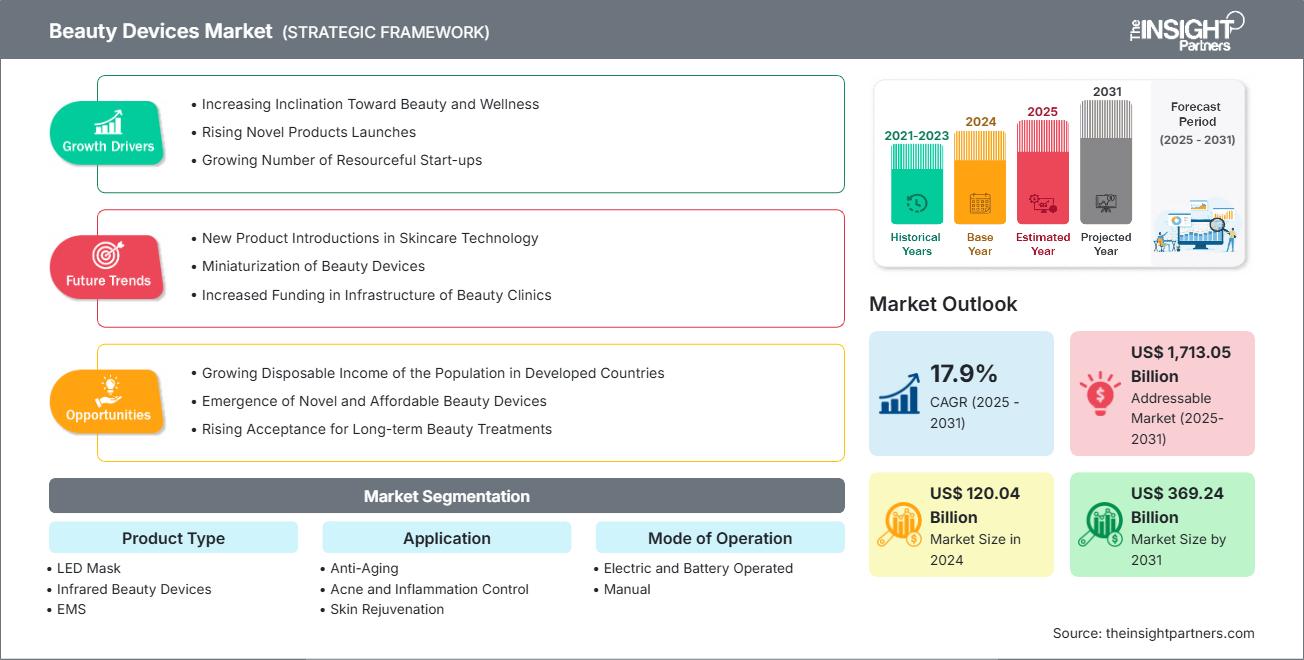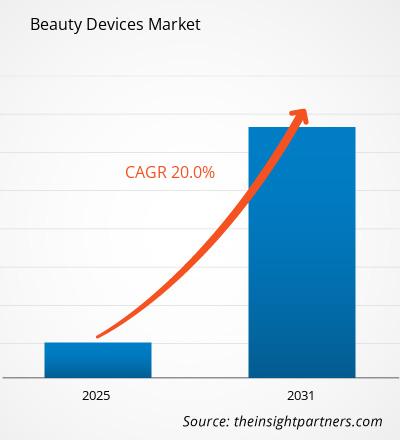预计到 2031 年,美容设备市场规模将从 2024 年的 1200.4 亿美元增至 3692.4 亿美元。预计该市场在 2025 年至 2031 年期间的复合年增长率为 17.9%。
美容设备市场分析
美容设备市场正经历强劲增长,这主要得益于几个关键因素。全球老龄化人口越来越多地寻求减少皱纹的解决方案,而不断增长的可支配收入以及社交媒体和美容意见领袖的影响力正在提升人们对美容设备的认识和采用率。集成了 LED 疗法、射频、声波振动和皮肤分析传感器等技术的智能、人工智能多功能设备推动了美容设备向家用的转变。
与此同时,消费者对环保和可回收产品的需求日益增长,促使美容公司和科技公司开展合作,以加速创新并提供个性化的护理解决方案。消费者对抗衰老疗法(包括LED面膜、微电流美肤工具和家用激光设备)兴趣的激增,反映出消费者对健康和自我护理的关注度日益提升。
美容设备市场概览
随着消费者美容意识的不断提升,全球美容设备市场正在加速发展,尤其是在寻求非侵入式、家用抗衰老、焕肤和脱毛解决方案的老龄化人群中。此外,社交媒体、网红和名人代言在提升消费者认知度和推动购买决策方面发挥了重要作用。技术创新增强了个性化和有效性,从而推动了美容设备的普及。市场参与者的增长计划也有望带来丰厚的商机。例如,2024年2月,Cutera 正式发布了 AviClear,这是首款获得FDA批准的基于能量的美容设备,用于治疗轻度、中度和重度痤疮。 AviClear 在英国和澳大利亚均有销售。
自定义此报告以满足您的要求
您将免费获得任何报告的定制,包括本报告的部分内容,或国家级分析、Excel 数据包,以及为初创企业和大学提供超值优惠和折扣
美容设备市场: 战略洞察

- 获取本报告的主要市场趋势。这个免费样本将包括数据分析,从市场趋势到估计和预测。
美容设备市场驱动因素和机遇
您将免费获得任何报告的定制,包括本报告的部分内容,或国家级分析、Excel 数据包,以及为初创企业和大学提供超值优惠和折扣
美容设备市场: 战略洞察

- 获取本报告的主要市场趋势。这个免费样本将包括数据分析,从市场趋势到估计和预测。
市场驱动因素:
对美丽和健康的日益增长的倾向:
压力水平的增加、长时间的工作和生活方式的改变,再加上污染的增加,对皮肤和头发健康产生了负面影响。这增加了消费者对美容和健康解决方案的兴趣,包括射频滚轮和蓝光治疗设备。由于人们更加注重外表,对美容产品和服务的需求激增。由于人们更加注重外表,对美容产品和服务的需求激增。美容设备的技术进步:
通过 LED 疗法、射频、超声波技术或人工智能应用程序的干预,美容设备现在更有效,也更易于使用。这种增强功能即将改变家庭美容护理的功效、安全性和可接受性,从而扩大市场应用范围。
市场机遇:
新兴经济体扩张:
印度、中国、巴西和东南亚等新兴经济体的快速城市化、可支配收入水平的提高以及美容意识的增强是主要的增长机会。随着这些地区的消费者能够更多地接触国际美容趋势和电子商务,对美容设备的需求可能会大幅增长。智能互联技术的集成:
随着人工智能、物联网和移动应用程序集成到美容设备中,定制化的护肤解决方案现已成为可能。科技爱好者青睐能够检测皮肤状况并根据自身需求进行护理的智能设备,这为更新的创新和更强大的客户互动铺平了道路。
美容设备市场报告细分分析
美容设备市场被划分为不同的细分市场,以便更清晰地了解其运作方式、增长潜力和最新趋势。以下是大多数行业报告中使用的标准细分方法:
按产品类型:
LED 面膜:
LED 面膜美容仪是一种创新的护肤工具,它利用发光二极管 (LED) 技术来改善皮肤健康和外观。这些面膜因其有效性和非侵入性而在美容和保健行业越来越受欢迎。红外美容仪:
红外美容仪是一种护肤工具,它利用红外光(通常为近红外光谱)穿透皮肤深层,从而改善皮肤健康、促进愈合并提升整体外观。EMS:
电刺激肌肉 (EMS) 美容仪是一种护肤工具,它利用电脉冲刺激面部肌肉,提供一种非侵入性方法来改善肤色、肤质和整体外观。EMS 技术已应用于医疗和治疗领域。其他:
其他设备包括光激光疗法、皮肤滚轮、射频 (RF) 设备、氧蒸机和消脂仪。氧蒸机用于疏通毛孔和减少痤疮问题。它们广泛用于芳香疗法。消脂疗法包括微创激光治疗,以减少皮下脂肪。
按应用:
抗衰老:
抗衰老设备旨在减少或逆转衰老的可见影响,例如细纹、皱纹和皮肤松弛。这些设备通常使用射频、LED 光疗和微电流来刺激胶原蛋白生成、收紧皮肤并改善皮肤弹性。痤疮和炎症控制:
与污染和压力相关的皮肤问题、对非侵入性治疗的偏好以及护肤意识的提高正在显著提高。目前正在开发用于治疗痤疮、粉刺和皮肤炎症的设备,通过针对爆发的根本原因(例如细菌、多余油脂和堵塞的毛孔)来治疗。皮肤焕新:
皮肤焕新设备旨在改善整体外观和皮肤健康。这些设备通常使用激光疗法、微晶磨皮、LED 灯和微针来刺激皮肤更新、去除死皮细胞并促进胶原蛋白的生成。其他:
其他部分包括脱毛、紧致皮肤、色素沉着治疗和整体皮肤健康维护等应用。对多功能设备的需求不断增长,注重便利性和易用性,以及个人护理技术的创新。
按操作模式:
- 电动和电池供电
- 手动
按分销渠道:
- 在线
- 离线
按地域:
- 北美
- 欧洲
- 亚太地区
- 拉丁美洲
- 中东和非洲
北美美容设备市场预计将占据相当大的市场份额。该地区消费者日新月异、忙碌的生活方式,正在推动对多功能美容和个人护理产品的需求增长。此外,脂肪团堆积带来的肥胖风险和影响,也吸引了消费者对特殊化妆品和美容设备的需求。
美容仪器市场
The Insight Partners 的分析师已详尽阐述了预测期内影响美容设备市场的区域趋势和因素。本部分还探讨了北美、欧洲、亚太地区、中东和非洲以及南美和中美洲的美容设备市场细分和地域分布。
美容设备市场报告范围
| 报告属性 | 细节 |
|---|---|
| 市场规模 2024 | US$ 120.04 Billion |
| 市场规模 2031 | US$ 369.24 Billion |
| 全球复合年增长率 (2025 - 2031) | 17.9% |
| 历史数据 | 2021-2023 |
| 预测期 | 2025-2031 |
| 涵盖的领域 |
By 产品类型
|
| 覆盖地区和国家 | 北美
|
| 市场领导者和主要公司简介 |
|
美容设备市场参与者密度:了解其对业务动态的影响
美容设备市场正在快速增长,这得益于终端用户需求的不断增长,而这些需求的驱动因素包括消费者偏好的不断变化、技术进步以及对产品优势的认知度不断提高。随着需求的增长,企业正在扩展产品线,不断创新以满足消费者需求,并抓住新兴趋势,从而进一步推动市场增长。

- 获取 美容设备市场 主要参与者概述
按地区划分的美容设备市场份额分析
预计未来几年亚太地区将增长最快。拉丁美洲、中东和非洲等新兴市场也为美容设备供应商提供了许多尚未开发的扩张机会。
各地区的美容设备市场增长情况不同。这是因为各地区拥有庞大的人口基数,他们渴望拥有无皱纹和无痤疮的肌肤。日益增多的皮肤相关问题、人们对皮肤护理程序的认识不断提高以及技术设备的进步推动了市场的增长。以下是按地区划分的市场份额和趋势摘要:
1.
市场份额:
占据全球市场的很大一部分关键驱动因素:
- 消费者不断变化和忙碌的生活方式
- 脂肪团积累引起的肥胖风险和影响
- 庞大的人口群体渴望拥有无皱纹和无痤疮的肌肤
趋势:
美容设备制造商采用有机和无机策略。
2.
市场份额:
相当大的市场份额关键驱动因素:
- 消费者对个人修饰和外表的意识不断提高
- 电子商务的兴起
趋势:
技术进步推动了创新和用户友好的美容设备的发展
3. 亚太地区
市场份额:
增长最快的地区,市场份额每年都在增长关键驱动因素:
- 城市化和不断增长的中产阶级人口
- 韩国美容和日本美容趋势的影响
- 社交媒体和美容影响者的受欢迎程度。
趋势:
医疗旅游业兴起
4. 南美洲和中美洲
市场份额:
市场稳步增长关键驱动因素:
- 对非侵入性治疗的偏好日益增长
- 政府倡导健康和保健的举措
趋势:
对家用美容设备的需求增加
5.中东和非洲
市场份额:
虽然规模小,但增长迅速关键驱动因素:
- 不断扩大的医疗保健基础设施
- 男性和女性越来越注重个人美容
趋势:
对非侵入性美容手术的偏好日益增长。
美容设备市场参与者密度:了解其对业务动态的影响
高市场密度和竞争
由于荷兰皇家飞利浦和松下控股等老牌企业的存在,竞争非常激烈。区域和利基供应商也在加剧不同地区的竞争格局。
这种激烈的竞争促使公司通过提供以下产品脱颖而出:
- 先进的产品
- 增值服务,例如定制和可持续解决方案
- 有竞争力的定价模式
- 遵守监管准则
机遇与战略举措
- 消费者对能够个性化护肤程序或提供实时反馈的人工智能/物联网设备越来越感兴趣。
- 具有环保意识的消费者更喜欢可充电或低浪费的设备。
- 通过订阅模式提供可再填充的墨盒、配件或基于应用程序的高级功能。
在美容设备市场运营的主要公司有:
- 荷兰皇家飞利浦公司
- 松下控股公司
- Silk’n
- MTG 有限公司
- 欧莱雅公司
- Lumina NRG
- Tria Beauty
- FOREO
- Hitachi Ltd
- Ya-Man LTD
免责声明:以上列出的公司排名不分先后。
研究过程中分析的其他公司:
- Candela Corporation
- Conair LLC
- Lumenis Ltd.
- Cynosure
- Sciton
- LUTRONIC
- STRATA Skin Sciences
- El.En. SpA
- Sofwave Medical
- Syneron Medical
- CurrentBody
- Spectrum Brands
- Sofwave Medical
- CurrentBody
- Medicube
美容设备市场新闻和最新发展
NuFACE 推出了其 NuFACE FIX MicroWand。
这款尖端设备采用 NuFACE 标志性的微电流技术和精确的微球体,旨在刺激皮肤表层,消除眼部浮肿、丰唇和抚平细纹。
松下推出了新款纳米护理吹风机 EH-NA0J,展示其在美容解决方案方面的持续创新。
Panasonic Beauty 品牌旨在提供卓越的头发、皮肤和身体护理。松下独特的纳米水润技术,能够从空气中提取水分,形成细小、富含水分的颗粒,深入毛干。这项技术能够减少静电,消除恼人的乱发。因此,您的头发会变得顺滑、更易于打理、更少毛躁,并且光泽度更高。
美容设备市场报告覆盖范围和可交付成果
《美容设备市场规模和预测(2021-2031)》报告对市场进行了详细的分析,涵盖以下领域:
- 美容设备市场规模以及全球、区域和国家/地区范围内涵盖的所有主要细分市场的预测
- 美容设备市场趋势以及市场动态,例如驱动因素、限制因素和关键机遇
- 详细的 PEST 和 SWOT 分析
- 美容设备市场分析涵盖主要市场趋势、全球和区域框架、主要参与者、法规和最新市场发展
- 行业格局和竞争分析涵盖市场集中度、热图分析、知名参与者和美容设备市场的最新发展
- 详细的公司个人资料
- 历史分析(2 年)、基准年、预测(7 年)及复合年增长率
- PEST和SWOT分析
- 市场规模、价值/数量 - 全球、区域、国家
- 行业和竞争格局
- Excel 数据集
近期报告
客户评价
购买理由
- 明智的决策
- 了解市场动态
- 竞争分析
- 客户洞察
- 市场预测
- 风险规避
- 战略规划
- 投资论证
- 识别新兴市场
- 优化营销策略
- 提升运营效率
- 顺应监管趋势




















 获取免费样品 - 美容设备市场
获取免费样品 - 美容设备市场